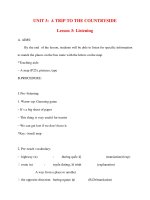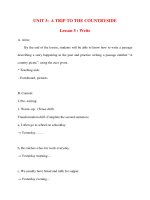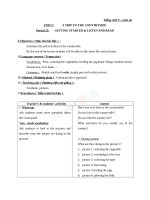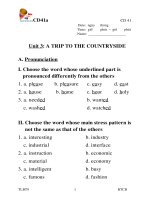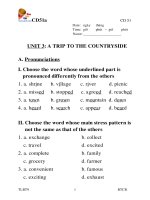Giáo án Tiếng Anh 9 Unit 3: A trip to the countryside
Bạn đang xem bản rút gọn của tài liệu. Xem và tải ngay bản đầy đủ của tài liệu tại đây (133.12 KB, 13 trang )
Giáo án Tiếng Anh 9
UNIT 3: A TRIP TO THE COUNTRYSIDE
Lesson 1: Getting started – Listen and Read
I. Objectives:
- By the end of the lesson, Ss know about the life and activities in the countryside.
II. Language contents:
* Grammar:
- Modal could with wish
- The Past Simple with wish
*Vocabulary:
- Home village, bamboo forest, banyan tree, shrine, river
III. Technique:
Question – Answer.
IV. Teaching aids:
Picture, cards
V. Time:
45 minutes
VI. Teaching procedure:
Steps
Warm-up
Activities
- Asking Ss some question about the countryside
+ Have you ever been to the countryside?
+ How often do you go there?
+ Where is it?
+ Have you got any relatives there?
+ Are you used to the country life and activities?
Pre-reading
- Asking Ss to look at the picture and describe what the people are
doing in the picture:
1. watering the vegetables
2. swimming
3. feeding the pigs
4. harvesting (the farmers are harvesting)
5. feeling the pigs
6. Plowing in the field.
7. A buffalo boy is flying his kite
8. Some children are playing football.
- Pre-teaching new words: home village, bamboo forest, banyan tree,
While- reading
shrine, river
- Asking Ss read the text and answer the questions:
a. What did Ba, Liz and his family do on their journey to his home
village?
b. What did Liz think of the trip?
* Answers:
a. They visited Ba’s uncle, walked up the mountain to visit a shrine,
went boarding in the river and had a picnic on the riverbank.
b. Liz enjoyed the trip very much, she took a lot of photos.
- Asking Ss to read the statements on page 23 and decide which is true
and which is false (pair work)
- Giving feedback:
1 F ( Ba and his family had a day trip to there home village)
2T
3 F (There is a big old banyan tree at the entrance to the village)
4 F ( People had a snack under the banyan tree)
5T
6 F ( People had a picnic on the river bank)
7T
8 F (Liz had a lot of photos to show her parent)
9T
- Having Ss work in pairs to answer the questions (page 23)
1. It’s 60 kilometers the north of Hanoi
2. They got to village by bus
3. It’s is at the entrance to the village
4. They saw the shrine of a Vietnamese hero on the mountain.
5. They had a picnic on the river bank
6. Liz took a lot of photos to show her parents.
7. Liz wishes she could visit Ba’s village again.
Post-reading
- Asking Ss to talk to each other about the activities they see in the
picture on page 22.
Homework:
- Learn by heart new words
- Prepare next lesson: Unit 3/ Lesson 2 Speak
UNIT 3: A TRIP TO THE COUNTRYSIDE
Lesson 2-3:
SPEAK AND LISTEN
I. Objectives:
By the end of the lesson, Ss know how to
- Ask for and give information about their home village
- Develop listening and speaking skills
II. Language contents:
1. Grammar:
- Simple Present
- Simple Past
2. Vocabulary:
III. Technique:
Question – answer
IV. Teaching aids:
Picture, cards.
V. Time:
45 minutes
VI. Teaching procedure:
Steps
Warm-up
Activities
Asking Ss some questions about the countryside:
+ Where is your home village?
+ What can you see on the way to your village?
+ How far is it from the city?
+ Are there any interesting places in your village?
Speaking
- Having Ss read the questions in exercise a – page 24, work in
pairs, ask and answer about their partner’s home village, using
information in the box.
- Telling Ss to cover the role that they don’ts play.
Example:
A: Where is your home village?
B: It’s to the west of the city.
A: How far it is from the city?
B: It’s about 15 kilometers from the city.
A: How can your get there?
B: We can get there by bus.
A: How along does it take to get there?
B: It takes an hour.
A: What do the people do for a living in your village?
B: They plant rice and raise cattle.
A: Does you village have a river?
B: There aren’t any rivers, but there is a big lake.
- Asking some opairs to perform their dialogue in front of the
class.
- Giving remarks
Pre-listening
- Teaching some new words: a route – a pond – parking lot =
car park – to pick someone up
- Introducing the text: You will listen to the trip to Ba’s village
- Asking Ss to look at the map, guessing where the places on the
map are and compare with their partners.
- Writing their guesses on the board.
While-listening
- Having SS listening to the tape and check their predictions.
- Matching the places on the bus route with the letter on the map
is and compare with their partners.
- Giving feedback:
* Answer:
A banyan tree
B airport
C highway No 1
D Dragon bridge
E Gas station
F store
G pont
H bamboo forest
I parking lot
Post-listening
- Asking Ss to show each other the bus route they have just
listened to.
Homework:
- Learn by heart new words.
- Prepare next lesson: Unit 3/ Lesson 3 Read
UNIT 3: A TRIP TO THE COUNTRYSIDE
Lesson 4:
READ
I. Objectives:
By the end of the lesson, Ss will able to
- Understand the text in details.
- Develop reading skill
II. Language contents:
1. Grammar:
2. Vocabulary:
- Exchange students – grow maize – grocery store - baseball
III. Technique:
Question – Answer
IV. Teaching aids:
Pictures, cards
V. Time:
45 minutes
Steps
Warm-up
Pre-reading
Activities
- Asking Ss “exchange students” means
- Introducing the text:
Van is an exchange student. He is from HCM city. He is now studying in
the USA. He is living with the Parker family on a farm outside
Columbus, Ohio.
- Having Ss tell the class what they know about life in the country, on the
farm – what do the people do? How do they relax? (pair word)
- Pre-teaching some new words: exchange students – grow maize –
grocery store – baseball
While-reading
- Asking Ss to read the text to answer the questions:
1. How long will Van stay there?
2. What do Mr. and Mrs. Paker do?
3. How many children do they have?
4. What does Van do after finishing his homework?
5. How does the Parker family spend their weekend?
- Giving feedback:
1. He will stay there till the beginning of October.
2. Mr. Parker is a farmer and Mrs. Parker works part time at a grocery
store.
3. Two girls.
4. He feeds the chicken and collects their eggs.
5. They eat hamburger or hot dog while they watch Peter play.
- Asking Ss to work in pairs read the text and match the words in column
A with the explanation in column B.
- Giving feedback.
Answer: maize
Feed
Grocery store
corn
give food to eat
where people buy food and small
things
Part-time
shorter or less than standard time
Collect
bring things together.
- Asking Ss to read the summary and then the text, complete the
summary, using the information from the passage (pair work)
- Asking one student to read the complete summary in front of the class.
Answer:
a. Ohio
2. Farmer
3. works part-time at a grocery store
4. Petter
5. Sam
6. After
8. They watch
9. Baseball
7. farm
10. member
- Correcting their mistakes.
Post-reading
- Asking Ss to work in pair. One is Van who has just come back from the
USA. The other is a student who is going to the USA as an exchange
student.
A: Hi, Van. I’m going to the USA next month as an exchange student. I
want to know what o should do when I’m in the USA. Can you help me?
B: Sure. Where are you going to stay?
A: I’m going to stay with The Browns. They live in a suburb.
…
Homework:
Write the summary into the notebook.
Prepare next lesson: Unit 3/Lesson 5 Write
UNIT 3: A TRIP TO THE COUNTRYSIDE
Lesson 5:
WRITES
I. Objectives:
By the end of the lesson, Ss can
- Write a paragraph describing a story happened in the past – a picnic in the
countryside.
- Develop writing skill
II. Language contents:
1. Grammar:
- Past Simple Tense
2. Vocabulary:
Blanket – to lie out – to gether – site
III. Technique:
Question – Answer
IV. Teaching aids:
Pictures, cards
V. Time: 45 minutes.
VI. Teaching procedures:
Steps
Warm-up
Activities
- Ask Ss to answer some questions about going on a picnic
+ Have you ever gone a picnic?
+ When did you go?
+ How did you get there?
+ What did you come back?
+ Did you enjoy it?
Pre-writing
- Pre-teach vocabulary: blanket-to play out –to gather-site
- Ask Ss to look at the picture and read the cues.
- Have Ss to describe the picture to their partners.
- Ask SS to tell what they can see in each picture.
While-writing
- Ask Ss to write a passage entitled “A country picnic”
- Ask Ss to use the picture and cues to write the passage:
It was a beautiful day, my friends and I decided to go on a picnic. We took
a bus to the countryside and then walked about 20 minutes to the picnic
site next to the river. We put down the blanket and laid out the food. After
meal we played the games “What song is it?” and blind man’s buff. Late in
the afternoon we went fishing. We enjoyed our picnic. When we looked at
the time, it was nearly 6.30pm. We hurriedly gathered our things and ran
to the bus stop. We were lucky to catch the last bus and we arrived home
very late in the evening.
Post writing
- Ask Ss to compare with their partner and correct if they can.
- Choose some writings to correct in front of the class.
Homework:
- Write their passage in the notebook
- Prepare next lesson: Unit 3/Lesson 6: Language Focus.
UNIT 3: A TRIP TO THE COUNTRYSIDE
Lesson 6:
LANGUAGE FOCUS
I. Objectives:
- By the end of the lesson, Ss can review:
Modal could with wish
The past simple simple with wish
Prepositions of time
Adverb clauses of result
II. Language contents:
1. Grammar:
Modal could with wish
The past simple simple with wish
Prepositions of time
Adverb clauses of result.
III. Technique:
Questions – Answer
IV. Teaching aids:
Pictures, cards
V. 45 minutes
VI. Teaching procedure:
Exercise 1
Activities
- Revision: WISH: expresses wishes about the present / future.
WISH + S + Simple Past (be_were)
- Asking Ss to look at the picture and answer the questions:
a. Where is Hoa now? How does she feel?
b. What is the boy doing? What does he have in his mind?
…
- Asking Ss do exercise 1 – page 28, 29 (pair work)
- Correcting the mistakes.
Exercise 2
- Reviewing the prepositions on – at – in - with
- Looking at he itinerary on page 30 and answers the questions:
+ What does he do on first day?
Exercise 3
- Reviewing the use of the Past Simple and the Present Perfect.
We use The Past Simple tense to talk about definite. The Present
Perfect Tense to talk about indefinite past time.
- Asking Ss to read dialogue
- Asking Ss to word in pairs to practice asking and answering about
each of the items in the box.
- Correcting the mistakes if necessary.
Exercise 4 and 5
- Reviewing the passive voice: BE + Past Past Participle
- Having Ss do exercises 4 and 5
- Correcting theirs mistakes.
Homework:
- Do exercises page 20 - 21?
- Prepare next lesson: Unit 4/Lesson 1: Getting Started – Listen and Read.


